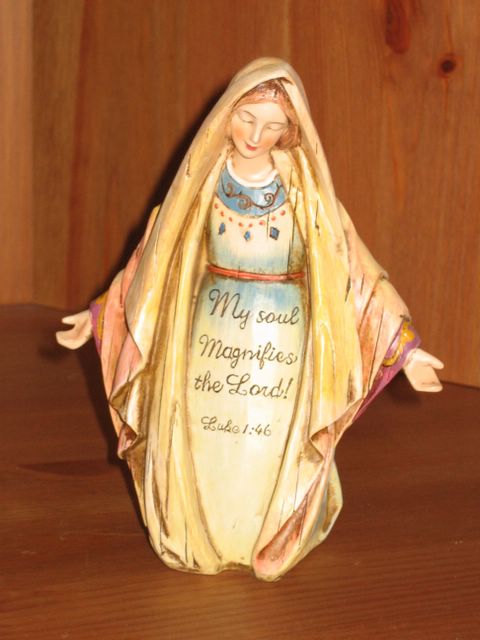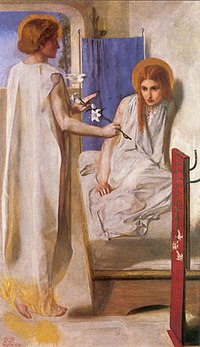And by the way, everything in life is writable about if you have the outgoing guts to do it, and the imagination to improvise. The worst enemy to creativity is self-doubt. - Sylvia Plath
Wednesday, December 20, 2006,11:38 AM
Mary

Mary seems to be in the spotlight this season. With the release of The Nativity Story movie (which I have not seen yet) and Scot McKnight's book The Real Mary (which I did read), she has become the topic of numerous conversations and sermons. I preached a couple of weeks ago on Mary and what we must weigh in the balance if we desire to be used by God. Our Emergent Cohort up/rooted got to spend an evening with Scot McKnight discussing his book (read about it at Mike's blog). The discussions have ranged from addressing the historical context for Mary, to the Catholic/Protestant controversies, to the implications for women in ministry.
What really intrigued me was the discussion of how Mary has been portrayed in art and how that has influenced our perceptions of her. Most depictions of Mary present her as emotionless, ageless, and weak in a pale blue dress. She is decorative, humble, and seemingly powerless. The picture to the left is the Mary from my Nativity set. I like that it has color on it and uses a verse from the Magnificat, but it still is a very traditional Mary. I had never been a fan of religious art mostly because of the way it portrays "holy" figures as disconnected from real life. The Marys in art obviously have not just given birth, finished a long journey, or had recently been on a roller-coaster emotional journey. They are not surprised by the appearance of an angel, are not phased by the request from God, and are not upset by a serious life change. And they are not the kind of women who could sing a politically revolutionary song like the Magnificat. Perhaps that is why when I first encountered Ecce Ancilla Domini by Dante Gabriel Rossetti I was drawn to it.
 Although it makes use of a lot of the traditional symbols associated with Mary, it challenges tradition as well. Of course in expected fashion it was rejected by critics of Rosetti's day because it was new and different. Contemporary critics howled with outrage at the picture, denouncing it as ‘an example of the perversion of talent which has recently been making so much headway’. I liked it because it depicts a Mary who has emotions - who reacts in some way to the appearance of the angel and his startling request. Here she is scared to death, cowering in the corner, unsure of her fate. Rossetti (using his sister Christine Rossetti as a model) portrays a real person here and I like that.
Although it makes use of a lot of the traditional symbols associated with Mary, it challenges tradition as well. Of course in expected fashion it was rejected by critics of Rosetti's day because it was new and different. Contemporary critics howled with outrage at the picture, denouncing it as ‘an example of the perversion of talent which has recently been making so much headway’. I liked it because it depicts a Mary who has emotions - who reacts in some way to the appearance of the angel and his startling request. Here she is scared to death, cowering in the corner, unsure of her fate. Rossetti (using his sister Christine Rossetti as a model) portrays a real person here and I like that.But I'm not sure the portrayal is accurate. Yes, I believe there was surprise and fright involved in the encounter. But Rosetti's Mary doesn't look like she would willingly say "may it be to me as you have said" in response to this angel. This angel with the phallic symbol lily pointed at Mary's womb seems to represent the worst form of male violence towards women. One is reminded of Yeat's poem Leda and the Swan retelling the Greek myth of the maiden being raped by the god. But I can't seem to figure rape into the Christmas story - the God I believe in (the God I want to believe in) is not like that. I have to think that Mary's "may it be" was a true willingness. At up/rooted Nanette Sawyer commented on God waiting for that willingness from Mary. She suggested reading the poem Annunciation by Denise Levertov. I especially like this description of Mary from that poem - "She was free/to accept or to refuse, choice/integral to humanness." Mary knew what she faced, she knew the dangers and she still willingly accepted to bear the Messiah. As Scot McKnight mentioned "may it be" might be better translated as "bring it on," this was a women with fire in her eyes ready to serve and serve big.
I like that vision of Mary. I like finding strong women in the Bible who aren't afraid to challege tradition and cultural assumptions in order to work for a greater good. I like that - that's the Bible I want to share with my daughter. But I have yet to find it in art. What will it take for the concept of a strong and revolutionary Mary to enter the religious consciousness? What will it take for the church to accept a woman with fire in her eyes? Will she (they) just continue to be shoved out of churches or subdued and tamed? What will it take for Mary to be re-imagined by the masses? Given the church's track record with women, I'm not expecting much. But this is a story I will tell - a picture I will paint differently.
Technorati Tags:
Labels: Book Reviews, Reflections

















Thank you, Julie, that was a marvelous reflection, and you helped me out with something. For years I've both loved Rossetti's painting and yet found it disturbing in some way I couldn't name. You just gave me some language to verbalize what was roiling in the back of my head every time I looked at that piece.
I've got two little girls myself. I want them to grow up to be like their great-grandmother, who traveled the world, survived a war and the loss of three husbands, pastored six churches over the course of fifty-five years of ministry and fell asleep in Christ this past February with a profound testimony of God's grace.
Jean Matkin didn't wait around for the men to accept her. She charged ahead and did what needed doing and, remarkably, tons of men followed her (she always had more men in her churches than women, which you know is unusual). She had some of Mary's fire in her, I think. Her experience, and Mary's, and yours and that of so many other strong women I know reminds me every day that God loves it when his daughters are audacious, and he stands by them. Thanks again.